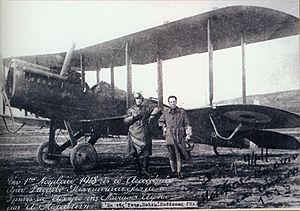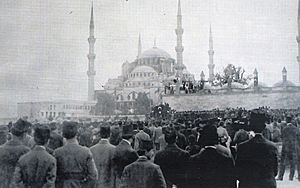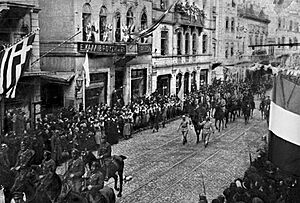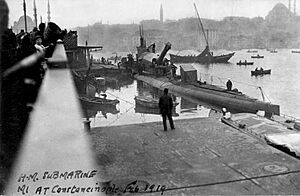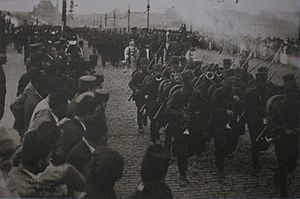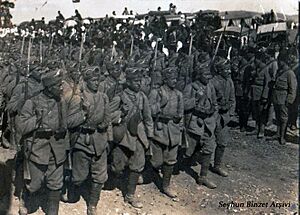Occupation of Istanbul facts for kids
Quick facts for kids Occupation of Istanbul |
||||||||||
|---|---|---|---|---|---|---|---|---|---|---|
| Part of the partition of the Ottoman Empire and the Turkish War of Independence | ||||||||||
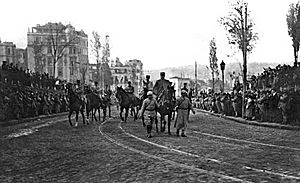 Louis Franchet d'Espèrey marching in Beyoğlu, 8 February 1919 |
||||||||||
|
||||||||||
| Belligerents | ||||||||||
|
||||||||||
| Commanders and leaders | ||||||||||
|
|
||||||||||
| Strength | ||||||||||
|
Land forces on 13 November 1918: |
||||||||||
The occupation of Istanbul (also known as Constantinople) was a time when the city was controlled by foreign forces. This happened from November 12, 1918, to October 4, 1923. Istanbul was the capital of the Ottoman Empire at the time.
Forces from the British, French, Italian, and Greek armies took control. This happened after World War I ended for the Ottoman Empire. The first French troops arrived in Istanbul on November 12, 1918. British troops followed them the very next day. Italian soldiers landed in the Galata area on February 7, 1919.
The Allied troops divided Istanbul into different zones. They set up a military government in December 1918. The occupation happened in two main parts. First, it followed an agreement called the Armistice of Mudros. Later, in 1920, it became more official under a new agreement called the Treaty of Sèvres.
Finally, the Treaty of Lausanne was signed on July 24, 1923. This treaty officially ended the occupation. The last Allied troops left Istanbul on October 4, 1923. Two days later, on October 6, 1923, Turkish troops entered the city. This day is now celebrated every year as Liberation Day of Istanbul.
This was the first time Istanbul had been taken over by foreign forces since 1453. This event, along with the occupation of Smyrna, helped start the Turkish National Movement. This movement eventually led to the Turkish War of Independence.
Contents
Why Did the Occupation Happen?
In 1920, Istanbul had between 800,000 and 1.2 million people. About half of them were Muslim. The rest were mainly Greek Orthodox, Armenian, and Jewish. Before the war, many people from Western Europe also lived there.
The Armistice of Mudros was an agreement that ended World War I for the Ottoman Empire. It was signed on October 30, 1918. This agreement mentioned occupying some forts near the Bosporus and Dardanelles. These are important waterways.
On that day, a British leader named Somerset Gough-Calthorpe said the Allies did not plan to take over the Ottoman government. He also said they would not place Istanbul under military control. However, this promise did not change what actually happened. Admiral Gough-Calthorpe's real view was to give "No kind of favour whatsoever to any Turk".
The Ottoman leaders were told that only British and French troops would occupy the forts. A small number of Ottoman soldiers could stay there as a sign of their country's power.
How the City Was Controlled
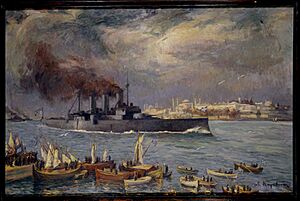
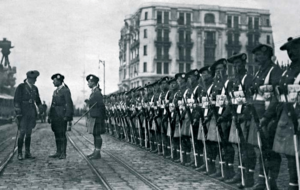
Allied forces began to take over Ottoman land soon after the Armistice of Mudros. Thirteen days later, on November 12, 1918, a French army group entered Istanbul. British troops arrived the next day. By early December 1918, Allied soldiers controlled parts of Istanbul. They set up a military government.
On February 7, 1919, an Italian group of soldiers landed in Istanbul. They were joined by police officers called Carabinieri the next day. The Carabinieri took on police duties in the city.
On February 10, 1919, the city was divided into three police zones. The old city (Stambul) was given to the French. The Pera-Galata area went to the British. Kadıköy and Scutari were given to the Italians. Admiral Somerset Gough-Calthorpe became the main military advisor for Istanbul.
Setting Up Authority
The British arrested some important Ottoman officials and sent them to Malta. They were waiting for trials for crimes during World War I. Gough-Calthorpe wanted to show that the military occupation was serious. He wanted to make it clear that not following orders would lead to harsh punishment.
Other Allied countries did not fully agree with this approach. But the Ottoman government and the Sultan understood the message. By February 1919, the Allies were told that the Ottoman Empire would fully cooperate.
Ottoman Trials
The Sultan understood Gough-Calthorpe's message. In the past, leaders would sometimes sacrifice people to calm down powerful forces. The Sultan hoped that blaming a few members of the Committee of Union and Progress would help the Ottoman Empire get a better deal at the Paris peace conference.
The trials started in Istanbul on April 28, 1919. The people on trial were accused of causing massacres. But the trials were not done well. Gough-Calthorpe wrote to London that the trials were "a farce" and hurt the reputation of both the Allies and the Turkish government.
Because of this, the Allies decided to move the trials to Malta. They called them "International" trials. However, these trials did not use any evidence from the Ottoman trials. Eventually, all the people sent to Malta were released.
A New Movement Begins
Gough-Calthorpe became worried when he learned that Mustafa Kemal, a hero from the Battle of Gallipoli, was made an inspector in Anatolia. Kemal's actions made the situation worse. Gough-Calthorpe asked for Kemal to be removed.
However, Kemal had friends in the government. They found a way to reduce his official power, at least on paper. By June 23, 1919, Gough-Calthorpe started to understand Kemal's role in starting the Turkish National Movement. He sent a report about Kemal to the British Foreign Office.
Gough-Calthorpe was given a different job on August 5, 1919, and left Istanbul.
John de Robeck Takes Over
In August 1919, John de Robeck replaced Gough-Calthorpe. He became the main commander and commissioner in Istanbul. He was in charge of things related to Russia and Turkey.
John de Robeck was very concerned about the Ottoman parliament's defiant attitude. By 1920, he heard that the Turkish National Movement was getting many weapons. Some of these weapons came from French and Italian sources. He wondered who these weapons would be used against.
Leaders met in London in February 1920 to discuss a peace treaty. John de Robeck warned them that Anatolia was becoming a place of resistance. He urged them to act quickly to control the Sultan and pressure the rebels. This was a difficult request, as promises of national freedom were being discussed.
The Treaty of Sèvres
Ottoman Parliament of 1920
The newly elected Ottoman parliament in Istanbul did not accept the occupation. They created a plan called the National Pact (Misak-ı Milli). This plan had six main ideas. It called for the right of people to govern themselves. It also asked for Istanbul's safety, the opening of the Straits, and an end to special rights given to foreigners.
At the same time, a movement in India called the Khilafat Movement tried to get the British government to protect the Ottoman religious leader (caliphate). Both the National Pact and the Khilafat Movement shared similar ideas. The Allies focused on these issues during the London Conference in February 1920.
The Ottoman Empire had lost World War I. But the National Pact and the Khilafat Movement were still fighting against the Allies.
Planning the Division of the Empire
The plans to divide the Ottoman Empire needed to be made final. At the London Conference on March 4, 1920, the Allies decided to put their secret agreements into action. This would become the Treaty of Sèvres. To do this, all resistance from the Ottoman Empire had to be stopped.
The Allies' military in Istanbul ordered actions to be taken. Political efforts also increased to write the Treaty of Sèvres. The treaty suggested that parts of the Ottoman Empire would be governed by Christian groups (Greek, French-Armenian, Italian, and American). The Muslim citizens of the Ottoman Empire felt this plan would take away their freedom.
British intelligence saw the Turkish national movement as a movement of Muslim citizens. The unrest across Anatolia led the British to believe that the Muslim government was not safe for Christians. They thought the Treaty of Sèvres was the only way to protect Christians. But enforcing this treaty meant stopping Mustafa Kemal's national movement.
The British military believed that if they could not control all of Anatolia, they could at least control Istanbul. The plan was to start in Istanbul, break down all organizations, and then slowly move deeper into Anatolia. This would lead to what became the Turkish War of Independence.
Military Control of Istanbul
Ending the Parliament, March 1920
Allied troops took over the Telegram House on March 14. On the morning of March 16, British forces, including the Indian Army, began to occupy important buildings. They also arrested nationalist politicians and journalists. During one operation, five Ottoman soldiers were killed when troops raided their barracks.
On March 18, the Ottoman parliament members met for a final time. They sent a letter of protest to the Allies, saying the arrests were wrong. The end of the Ottoman parliament left the Sultan alone with the British government.
On April 11, the Sultan announced his own decision to end the parliament. This happened after about 150 Turkish politicians were sent to Malta. After the parliament was dissolved, a newspaper called Yeni Gün (New Day) was raided and closed. This newspaper was important for sharing Turkish news with the world.
Official Declaration, March 16, 1920
On March 16, 1920, the Allied forces officially declared the occupation. They stated:
- General Sir George Milne and Allied forces occupied Istanbul to stop Turkish nationalism from spreading.
- The Allies promised they did not intend to take over the government.
- They wanted to keep the Straits open and protect the Armenians.
- The Allies convinced the Ottoman government to speak out against the Turkish nationalists. Many nationalists were sent away.
- The Sultan had set up a government led by Damad Ferid.
Enforcing the Peace Treaty
Early Pressure on the Resistance, April–June 1920
The British thought that local forces in Anatolia, with British training and weapons, should stop the Turkish National Movement. The Istanbul government appointed a general inspector and a new Security Army to enforce central government control with British help. The British also supported local groups with money and weapons.
However, these forces could not stop the nationalist movement. A fight outside İzmit quickly grew bigger. British forces fired on the nationalists and bombed them from the air. Even though the attack made the nationalists retreat, it showed how weak the British position was. The British commander, General George Milne, asked for many more soldiers. But the British government did not want to send so many troops.
Some Circassian exiles supported the British. Others remained loyal to Mustafa Kemal. The British soon realized that the nationalist movement, which had grown strong during World War I, could not be stopped without many well-trained soldiers. On June 25, the Security Army was disbanded because it was not helping.
Presenting the Treaty to the Sultan, June 1920
The terms of the Treaty of Sèvres were given to the Sultan in mid-June. The treaty was much harsher than anyone expected. But because of the military pressure on the resistance from April to June 1920, the Allies did not think there would be much opposition.
However, Mustafa Kemal had already set up a rival government in Ankara. This was the Grand National Assembly. On October 18, the government of Damat Ferid Pasha was replaced. The new leader, Ahmed Tevfik Pasha, wanted to approve the treaty if national unity could be achieved. This meant working with Mustafa Kemal. But Kemal hated the treaty and started a military attack. Because of this, the Turkish government told the Allies that the treaty could not be approved at that time.
End of the Occupation
The Turkish National Movement succeeded against the French and Greeks. Their forces then threatened the Allied forces at Chanak. The British decided to fight back if anyone tried to enter the neutral zone of the Straits. Kemal was convinced by the French to tell his forces to avoid any fighting at Chanak.
Still, the Chanak Crisis almost led to war. This was avoided on October 11, 1922, when the Armistice of Mudanya was signed. This agreement ended the Turkish War of Independence. How this crisis was handled caused the British government to fall on October 19, 1922.
After the Turkish War of Independence (1919–1922), the Grand National Assembly of Turkey in Ankara ended the Sultanate on November 1, 1922. The last Ottoman Sultan, Mehmed VI, was forced to leave Istanbul. He left on a British warship called HMS Malaya on November 17, 1922. He went into exile and died in Sanremo, Italy, on May 16, 1926.
Talks for a new peace treaty with Turkey began at the Conference of Lausanne on November 20, 1922. They started again on April 23, 1923, after a break. This led to the signing of the Treaty of Lausanne on July 24, 1923.
Under this treaty, Allied forces began leaving Istanbul on August 23, 1923. They finished leaving on October 4, 1923. British, Italian, and French troops left at the same time.
Turkish forces from the Ankara government, led by Şükrü Naili Pasha, entered the city with a ceremony on October 6, 1923. This day is celebrated every year as the Liberation Day of Istanbul. On October 29, 1923, the Grand National Assembly of Turkey declared the creation of the Turkish Republic. Ankara became its capital. Mustafa Kemal Atatürk became the first President of the Republic.
List of Allied High Commissioners
- November 1918 – 1919: Admiral Somerset Arthur Gough-Calthorpe
- August 1919 – 1920: Admiral John de Robeck
- 1920 – October 22, 1923: Sir Horace Rumbold
- November 1918 – January 1919: General Louis Franchet d'Esperey
- January 30, 1919 – December 1920: Albert Defrance
- 1921 – October 22, 1923: General Maurice Pellé
- November 1918 – January 1919: Carlo Sforza
- September 1920 – October 22, 1923: Camillo Garroni
- 1918–1921: Efthimios Kanellopoulos
- 1921–1923: Charalambos Simopoulos
- August 1919-October 1923: Admiral Mark Lambert Bristol
- April 1921-October 22, 1923: Sadatsuchi Uchida


